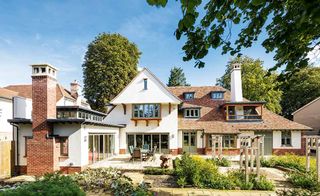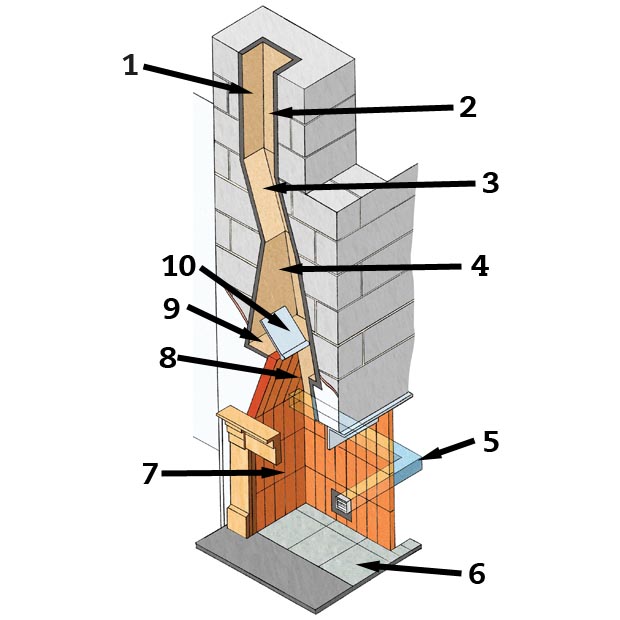Can A Fireplace That Was Deemed Unsafe Because Of Depth Be Repaired

Plumbing fixtures, altering or replacing an external flue or chimney or installing a new woodburning stove all fall nether the Building Regulations, although they are not typically tasks that require planning permission.
Every bit you lot'd expect, the requirements controlling new chimneys, flues and appliances are safety based and very detailed. When information technology comes to complying, you lot take a choice:
- using a HETAS installer registered nether the authorities's Competent Person Scheme to self-certify the work
- giving discover to your building control body.
Preparing for the Works
Information technology is essential to have the chimney inspected and swept before installation:
- Old chimneys are often inefficient and there's potential for lethal gases to leak through the chimney walls.
- Chimneys on party walls may have brick flues that share the same construction. They are quite capable of leaking from one to another – often only half-brick walls separate them – and hence it is possible to smoke out your neighbor'southward house by accident!
- No flue lining: Chimneys built earlier 1965 often have no flue lining and are in poor condition. Mortar joints are frequently corroded, 'eaten' away by acidic condensates and soot deposits. Because of this, and the risk of fume leakage, many installers insist on lining the chimney before installing a new appliance. While it isn't a Building Regulations requirement, it is the norm and certainly good practice.
If you're still keen to reuse an quondam unlined chimney, a visual inspection (by mirror and core ball) plus a smoke test are essential and should establish whether there are any problems.
Finally, theClean Air Act designates some areas as smoke control areas. This affects the blazon of appliance yous can install and the fuel that can exist burned in information technology. For more information contact the environmental health department at your local dominance.
Agreement Chimney Components

A handy breakdown of the components of a chimney
A Flue liningUsually made of refractory physical or impervious clay; sometimes metallic
B Flue Must be high enough for sufficient draught, around 4.5m in near cases
C Flue connector Connects the fireplace to the flue
D Smoke sleeping accommodationHere the smoke gathers before beingness passed into the flue
East Smoke shelfPrevents downdraughts
F DamperA pivoted sliding metallic flap that regulates the amount of draught, preventing excessive variations. It can likewise close off the fireplace from the exterior of the house, preventing air loss
G Get togetherImproves draught and reduces force per unit area in the smoke sleeping room
H Air Inlet Controls the quantity of outside air supplied for combustion
I HearthThe required thickness depends on the appliance
Re-lining Chimneys
In the past, the sectional flue systems of dirt, ceramic and concrete were used to re-line chimneys with bands at the joints. These take been replaced by flexible stainless steel tube flues that can be lowered down from the acme every bit a tube in 1 length. Many of these need to go in the correct way up and have arrows marked on them pointing in the direction of the fume — upwards. Some may not and information technology's possible to install them either manner, only information technology is essential to check with the manufacturer showtime.
- A smokeless fuelled stove not exceeding 20kW must take a diameter of no less than 125mm
- A stove over 20kW and up to 30kW, burning any solid fuel, must not be less than 150mm in bore
Your stove manufacturer volition also advise on the flue diameter, type and other requirements needed. It is best practice to install a minimum size of 150mm if you can to ensure it's safe to use, regardless of the type of fuel to be used.
Enamelled steel pipes are used to connect the stove to the chimney arrangement and as these volition go hot in use, they must exist positioned at least 3 times the bore of the flue away from combustible materials. For instance, a 150mm pipe must exist fixed at to the lowest degree 450mm away. This is especially relevant about to timber studwalls.
If the combustible material is separated from the flue by a non-combustible shield (for instance, a cement-based fire protection board used backside appliances), the distance can exist reduced to 1.5 times the diameter of the flue.
There is no maximum height for this connecting flue piping but it must non extend outside the room containing the stove. Keeping it every bit short as possible will besides assistance the chimney 'depict'.
New Masonry Chimneys
WARNING
Some bad examples spring to mind of single-skinned metal chimneys passing through a closet, room or roof infinite with DIY insulation that have resulted in serious fires. Even with the proprietary double-walled insulated types, at that place are still air gaps required and components to separate the chimney from any timber to maintain the fire resistance of the floor.
Unremarkably constructed of sectional flue liners and components fabricated from clay, ceramic and concrete, a new chimney tin exist formed by surrounding the liners with at to the lowest degree 100mm of brick, filling around the liners with vermiculite or insulating physical. All new chimneys must be congenital on suitable foundations with a damp-proof grade no less than 150mm above ground level and appropriate weathering where they laissez passer through the roof.
It is worth considering the type of brick and pointing to be used likewise, because some of the most decorative prove to exist less than weather-resistant later, resulting in damp walls as wind-driven rainwater penetrates.
Because even lined chimneys can nevertheless become hot, timber joists, floorboards or rafters must exist trimmed back by at least 40mm from the chimney outer face equally it passes through the roof and floors.
To some extent, the heat issue with masonry chimneys can exist overcome by choosing an insulated manufacturing plant-made chimney instead.They can be unsuitable in conservation areas, every bit the polished stainless steel of these big diameter models can await a scrap like a NASA launch site, All the same, they remain a popular culling to masonry chimneys. The casing encloses high performance insulation, which means that you lot can still touch on information technology when it is in use without getting burnt.
Outlets from Flues and Chimneys
The biggest complaint well-nigh chimneys comes from neighbours in urban areas who notice themselves downwind of a new one. Flue gases from the stove must exist able to discharge freely without presenting a fire or health hazard, whatever the current of air conditions.
This ways that the flue outlet needs to exist positioned sufficiently loftier above the roof surface and surrounding buildings to prevent it being affected by wind eddies or downdraughts. The Building Regulations identify the zone for this, but any of these dimensions may demand to exist increased where in that location is exposure to:
- high air current speeds
- adjacent tall buildings
- loftier trees
- high ground
Hearths for Stoves
Fires from stoves are rare simply they practice get super-hot and heat from the stove or burning fuel that might accidentally fall out of information technology needs to be considered. A hearth does the job as long as it is big enough:
- It should be raised from the normal flooring finish to identify it, and project at least 50mm from the stove sides and 300mm from the forepart of the stove when a stove is positioned within a fireplace recess
- For a freestanding stove (non in a recess) the hearth should be 840mm x 840mm
The thickness can be included as part of a solid concrete flooring slab or beam and block physical floor, while smaller stoves with lower operating temperatures can be of glass or thinner decorative materials.
Ventilation
The ventilation area is based on the rated output of the apparatus. Because nosotros now build homes with airtightness in mind for free energy efficiency, the ventilation needed has increased for homes built from 2006, which might have airtightness of five or less.
Some manufacturers now produce models with a 'total' or 'partial' straight air supply. This provides some or all of the air required for ventilation from an external air supply rather than from just within the room, to accost this consequence in airtight homes.
Carbon Monoxide
Information technology is also essential to ensure you accept a permanent source of air that keeps the stove burning efficiently and avoids the production of carbon monoxide, a highly toxic, colourless and odourless gas that has potentially fatal consequences.
Carbon Monoxide Alarm
Even with the ventilation provision met, the Regs require the installation of a carbon monoxide warning in rooms containing whatsoever solid fuel combustion apparatus. These devices are usually bombardment powered and have an warning to warning users when the working life of the detector is due to expire.
Alarms should exist within one-3m of the appliance and either:
- On the ceiling at least 300mm from whatsoever wall
- On a wall as high up as possible (to a higher place doors and windows) just at least 150mm from the ceiling
Commissioning
Many local authorities require installers to provide them with a commissioning checklist following the installation of a solid fuel stove and/or a new chimney or chimney lining. A blank example in the dorsum of Approved Document J can be used for this purpose. You should, in turn, be provided with a completion certificate from your installer or main contractor.
Full details of the relevant Building Regs can be found in the Canonical Certificate J (England and Wales) (opens in new tab) or Section three: Environment (Scottish Edifice Standards Guide 2022) (opens in new tab).
Paul is a edifice control officer and has written eight books on home improvements and building homes.
Can A Fireplace That Was Deemed Unsafe Because Of Depth Be Repaired,
Source: https://www.homebuilding.co.uk/advice/building-regulations-chimneys-stoves-and-fireplaces
Posted by: kimbutense.blogspot.com


0 Response to "Can A Fireplace That Was Deemed Unsafe Because Of Depth Be Repaired"
Post a Comment